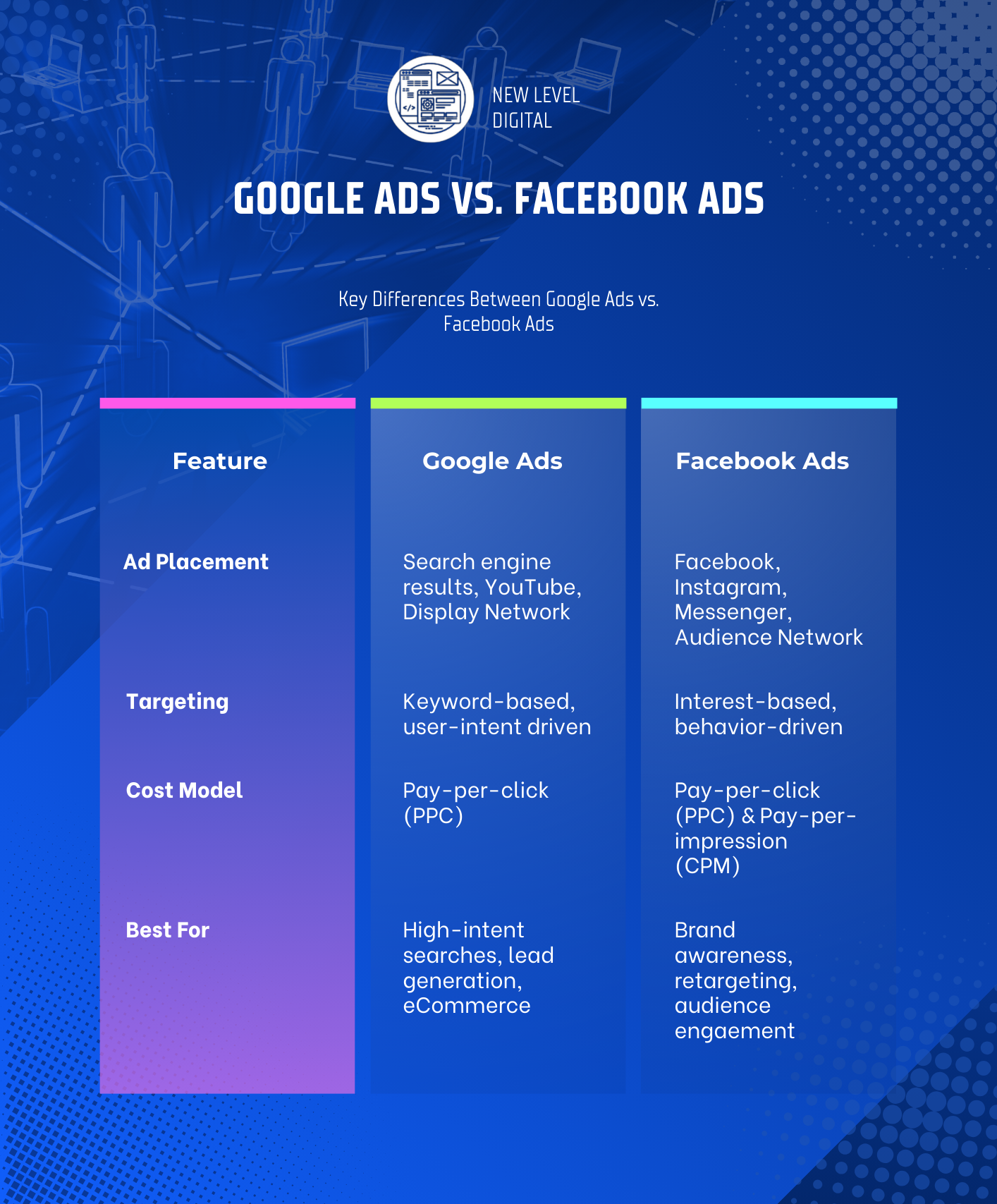Google Ads vs. Facebook Ads: Which Is Better for Your Business Goals?
Digital advertising is essential for businesses looking to attract customers and drive conversions, but choosing the right platform can be challenging.
So, Which is Better: Google Ads vs. Facebook Ads? It's a key debate among marketers. Google Ads captures high-intent users actively searching, while Facebook Ads excel in audience targeting and brand awareness.
The best platform depends on your business objectives—whether it's increasing immediate sales, reaching a broader audience, or maximizing ad spend efficiency.
Understanding the key differences will help you make an informed decision.
Overview of Google Ads
Google Ads is a pay-per-click (PPC) advertising platform developed by Google that enables businesses to display ads across the search engine, including Google Search, YouTube, and the Google Display Network. It is designed to help companies connect with potential customers who are actively searching for products or services.
How Google Ads Works
Google Ads uses a competitive bidding system where advertisers choose relevant keywords and set bids for ad placement. When a user searches for a specific term, Google determines which ads to show based on relevance, bid amount, and ad quality score. Advertisers only pay when someone clicks on their ad (PPC model), making it a cost-effective option for driving targeted traffic.
Purpose of Google Ads
Capture high-intent traffic: Search ads appear when users actively search for specific products or services.
Drive immediate conversions: Ideal for businesses looking to generate leads and sales quickly.
Boost local and national visibility: Helps businesses reach potential customers within a targeted location.
Improve brand credibility: Ranking at the top of Google search results enhances trust and authority.
Google Ads is a powerful tool that helps businesses reach their ideal customers and maximize their return on investment.
Overview of Facebook Ads
A powerful social media advertising platform that helps businesses reach targeted audiences based on demographics, behaviors, and interests. Facebook Ads generates demand by engaging potential customers before they actively search.
How Facebook Ads Work
Facebook operate on a bidding system where advertisers define their audience, choose an ad format, and set a budget. The platform uses an algorithm to display ads to users based on their past behavior and interests. Advertisers can pay per click (PPC) or per thousand impressions (CPM), depending on campaign goals.
Purpose of Facebook Ads
Increase brand awareness: Engage potential audience through visually appealing ads.
Target specific demographics: Use detailed audience filters for precise targeting.
Retarget website visitors: Re-engage previously active users.
Boost social engagement: Encourage likes, shares, and comments to expand reach.
Facebook Ads are ideal to build brand recognition, connect with new audiences, and drive engagement through social networks.
Key Differences Between Google Ads and Facebook Ads
| Feature | Google Ads | Facebook Ads |
|---|---|---|
| Ad Placement | Search engine results, YouTube, Display Network | Facebook, Instagram, Messenger, Audience Network |
| Targeting | Keyword-based, user intent-driven | Interest-based, behavior-driven |
| Cost Model | Pay-per-click (PPC) | Pay-per-click (PPC) & Pay-per-impression (CPM) |
| Best For | High-intent searches, lead generation, eCommerce | Brand awareness, retargeting, audience engagement |
Pros and Cons of Google Ads vs. Facebook Ads
Google Ads
✅ Pros:
High purchase intent (uses active search queries).
Immediate traffic with measurable ROI.
Benefits local businesses via Google Maps.
❌ Cons:
Higher cost-per-click (CPC).
Requires strong keyword research and optimization.
Facebook Ads
✅ Pros:
Excellent for a target audience and brand awareness.
Lower CPC compared to Google Ads.
Digital advertising formats like video, carousel, and lead forms.
❌ Cons:
Users have lower purchase intent.
Performance depends heavily on visuals and ad copy.
Cost of Google Ads vs. Facebook Ads
Google Ads: The average cost of CPC ranges from $0.10–$0.50, but may be higher in competitive industries.
Facebook Ads: The average cost of CPC is around $0.25–$.50, making it budget-friendly for engagement.
Which platform is more cost-effective?
It depends on your goals of advertising—Google Ads delivers higher conversion rates, while Facebook offers more cost-effective engagement.
Which is Better: Google Ads vs. Facebook Ads?
If your goal is immediate, direct conversions and local SEO → Google Ads.
Choose Google Ads If You Want:
To capture high-intent search traffic.
Immediate leads or sales (especially for service-based businesses).
To appear on Google Maps and local search results.
If your goal is long-term, brand awareness and audience engagement → Facebook Ads.
Choose Facebook Ads If You Want:
To build brand awareness and expand target audience.
To retarget website visitors or past customers.
To run visual-heavy advertising campaigns with videos and graphics.
Many businesses combine both in their marketing strategy—running Facebook Ads for awareness and Google Ads for conversions.
Need expert Google Ads management? Explore New Level Digital’s advertising services.
There is no one-size-fits-all answer: Your choice depends on advertising budget, audience, and campaign objectives. Optimize your advertising strategy with expert guidance from our team at New Level Digital.


